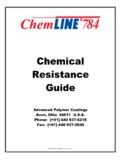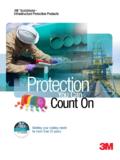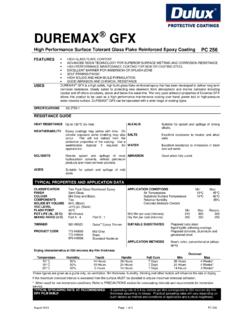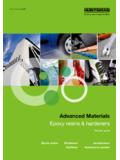Transcription of High performance industrial coatings for aggressive ...
1 high performance industrial coatings for aggressive Presents a History of PerformanceChemLine coatings from advanced Polymer coatings provide high performance corrosion protection. They are engineered using unique polymer technology to deliver excellent resistance to a wide range of aggressive coatings offer outstanding features and benefits, which can include:For product recommendations and technical, application and heat curing information contact advanced Polymer coatings customer service. Contact +01 440-937-6218. Resistance to aggressive chemical exposures, including strong acids, alkalis, gases, solvents and oxidizers Superior bond strength and adhesion to metal substrates, composites and concrete Virtually non permeable film minimizing cargo absorption and assuring content purity Wear and abrasion resistance Impact resistance Outstanding flexibility Steam cleanable Field repairable Complies with all FDA regulations high temperature resistance up to 500 F (260 C) Thermal cycling resistance -40 to +400 F (-40 to 204 C) Resists hydroblasting Excellent conductive / static dissipating properties Low surface tension ChemLine is generally recognized as safe (GRAS) for food grade cargoes.
2 PETROLEUM & REFININGChemLine coatings provide superior protection and corrosion resistance throughout petroleum production and refining facilities. Even at elevated temperatures, ChemLine coatings deliver a virtually non-permeable lining system that resists chemical and corrosive attacks. PIPELINEChemLine coatings are used to line the insides of pipes exposed to corrosive service conditions in oil exploration drilling. Durable ChemLine coatings handle aggressive fracking chemicals and acids, high pressure gases, high abrasion service, and high STORAGE & TERMINALSAt storage facilities, ChemLine protects tanks against aggressive acids, alkalis, solvents, CPPs, and edible oils, even at elevated temperatures. ChemLine polymer coatings are 97% to 100% solids with extremely low VOCs, making them the preferred lining system for bulk chemical storage Serves a Range of industrial MarketsTRUCK TRANSPORTATIONChemLine coatings provide advanced tank coating protection for over-the-road vehicles.
3 ChemLine s unique cross-linked polymer structure does not allow a chemical cargo to permeate the lining, thus providing corrosion resistance while ensuring product AND INLAND MARINEChemLine coatings have the unique ability to handle more than 5,000 chemicals including the full IBC range, hazardous cargoes, food grades, edible oils, fatty acids, black oils, solvents, spent acids, caustics and biodiesel Provides Enhanced Corrosion ProtectionRAIL TRANSPORTATIONChemLine coatings provide superior chemical resistance for tank and hopper cars. The coating s superior chemical resistance to thousands of chemicals provides lessors with the flexibility to change cargoes after simple cleaning and decontamination, with assurance of cargo purity.*Photos provided courtesy Resist-a-Line, Chicago, ILCHEMICAL PROCESSINGAt chemical plants facilities, ChemLine offers optimal protection against acids, caustics and solvents. Wherever hazardous chemicals pose problems tanks, pipes, stacks, digesters, and in or around processing equipment ChemLine delivers superior long-term (ISO) CONTAINERSAPC offers high performance ChemLine coatings for tank lining applications including tank containers (ISO tanks), intermediate bulk containers (IBCs), and bulk storage tanks, depending on specific needs of the product tanker container owner or transport GENERATIOND urable ChemLine coatings are specified to handle aggressive applications at power plants such as flue gas desulphurization systems and scrubbers, stacks, linings, ducts, chimneys, spray towers and fans.
4 ChemLine delivers chemical resistance and high heat capability to 500 F (260 C).Norval Amine A N N AOctanoic Acid A A AOrthonitro Benzene A N N NOleum A N N AOlive Oil Fatty Acid A A A APalm Oil Fatty Acid A A A APerchloroethylene A N N APerchloric Acid A N N NPhenol A N N APhosphoric Acid A N A NPhthalic Anhydride A N A APiperzine A N APolyethylene Polyamines A N APotassium Hydroxide A A L LPotassium Permanganate A A A LPropionic Acid A N N APyridine A N N ARubber Extender Oils A A A ARum A A A ASodium Carbonate A N A NSodium Dichromate A N A ASodium Hydroxide A A A LSodium Sulfide A A N NStannic Chloride A A A NStearic Acid A A A ASpent Sulfuric Acid A N N ASulfur A N N ASulfuric Acid 1-70% A A A NSulfuric Acid 70-99% A N N LSulphurous Acid A N N ATall Oil A A A ATallow Acid A A N ATar Acid A N A ATetra Chloroacetic Acid A N N NTetra Hydrofurfuryl Alcohol A N N
5 AToluene Diamine A N N AToluol A L L AValeraldehyde A N AVinegar A N A AVitriol Oil 65% A N A AWater, Acid A N N AXylenol A N N AAcetaldehyde A L N AAcetic Acid A N N AAcrolein Acid A N AAcrylic Acid A N N AAcrylonitrile, (35 C) A N N AAmmonium Persulfate A A A LAzabenzene A N N ABenzene A A N ABenzene Carboxylic Acid A A N ABenzoyl Chloride A N N NB-Methacrylic Acid A N N ABichromate of Soda A N A ABromine A N N AButanoic Acid A N AButyric Aldehyde A N A ACalcium Hydroxide A A A ACalcium Hypochlorite A A A LCaustic Potash A N N ACarbolic Acid A N N AChlorine Water A N A NChlorosulfonic Acid A N N NChlorinated Acetone A N N LChloracetic Acid A N N LChromic Acid, 20% A N A NCoal Tar Oil A N A ACoconut Fatty Acid A A A AColamine A N N ACresol A N ADichloromethane A N N ADetergents A A A ADiethyl Formamide A N N ADiethylamine A N N ADiethylene Chloride A N N LDiethyl Ether A N N ADimethylamide Acetate A N ADisulphuric Acid A N AEDTA A N A AEthanolamine A N N AEthonic Acid Anhydride A N AEthyl Acrylate A A N AFatty Acids A A A AFatty Acid.
6 Palm A A A AFerric Chloride A N A NFlaked Stearic Acid A N A AFluoraboric Acid* A N NFormaldehyde A A A AFormamide A N AFormic Acid 10% A N A AGreen Liquor A N A LGlycerol A N N AGrape Juice A A A AGrapefruit Juice A A A AGrease Oil A A A AHeptanoic Acid A A AHerring Oil A A A AHexahydroanaline A N AHMDA A N AHydrazine A N N AHydrobromic Acid A N A NHydrochloric Acid A N A N10% Hydrofluoric Acid* A N A N5-20% Hydrogen Chloride A N N10%-30% Hydrogen Sulfate A N A AIsobutanol A N A AIsobutyric Acid A N AIsopropyl Amine A N A AJavelle Water A N A NJuices, Fruit A A A ALactic Acid A A A ALactonitrile A N ALatex A A A ALiquified Ammonia A N N ALiquid Pitch Oil A N A AM-Phosphoric Acid** A N A LMaleic Anhydride A N A AMCA A N AMethacrylonitrile, (35 C) A N N AMethanamide A N AMethanol A N N AMEK A L N AMethylene Chloride A N N NMonochloro Benzene A N N NNaphtalene A N A ANitric Acid 1-20% A N A ANitro Benzene A A N ANitrogen Fertilizers A A AChemLine ChemLine ChemLine Phenolic EpoxyPhenolic EpoxyPhenolic EpoxyVinylesterVinylesterVinylesterStain less SteelStainless SteelStainless SteelA = Good at ambient temperatures L = Limited Service N = Not recommended* ChemLine 2400 Series ** ChemLine 784 SeriesCorrosion resistance data for Phenolic Epoxy, Vinylester and Stainless Steel from published is Only A Reference Guide.
7 This is an abbreviated listing of the more than 5,000 chemicals that have been tested. This information is intended to serve as a reference guide only. The end user is responsible for determining if ChemLine is the appropriate coating for the specifi c application involved. Contact your ChemLine Representative or the ChemLine Customer Service Hotline +01 440-937-6218 for detailed specifi cations prior to any fi nal coatings recommendation or Corrosion Resistance Performance31784/ high functionality forming up to 784 crosslinks. Majority of crosslinks are through Ether (C-O-C) bonds. Ether bonds are one of the strongest bonds in chemistry. Ether bonds give flexibility with chemical Technology; Epoxies, Vinylesters and ChemLine 784/32 Form 3 Dimensional Screen-Like Structures when CuredThe Greater the Distance Between the Crosslinks, the Greater the Permeation Causing Chemical Attack and AbsorptionProblems with Epoxies and VinylestersAggressive Chemical MoleculesSubstrate CorrosionAGGRESSIVE CHEMICAL MOLECULES PENETRATE INTO AND THROUGH THE POLYMER GROUPS ATTACKING BOTH THE INNER POLYMER STRUCTURE AND THE s and Epoxy s Open Screen StructureChemLine 784 s Closed Screen StructureAGGRESSIVE CHEMICAL MOLECULES CANNOT PENETRATE THE high DENSITY SURFACE.
8 INNER POLYMER STRUCTURE AND SUBSTRATE PROTECTED FROM CHEMICAL GroupCuring AgentEpoxy2 FunctionalityForms 4 Cross-linksThe Following Diagrams Represent the Same coating Cutaway (pictured left)ChemLine 784 high FunctionalityForms up to 784 Cross-links, the Highest Cross-link DensityThis is Only A Reference GuideContact your ChemLine Representative or the ChemLine Customer Service Hotline +01 440-937-6218 for detailed specifi cations prior to any fi nal coatings recommendation or application. performance Without Compromise PRODUCT NAMETEMP RATINGCURE SCHEDULEAPPLICATION METHODSYSTEM DFTTYPICAL APPLICATIONSFEATURES & BENEFITSChemLine 784/32784/32 EF784/32 PC-40 F to +400 F(-40 C to 204 C)200 F to 300 F (6 hours) (93 C - 149 C)SP,BR,RL,PC12-14 mils (steel) Reactors, chemical storage tanks, scrubbers, piping,ducts, rail cars, ISO tanks, OTR tankers, & barges* GRAS recognized. Excellent chemical resistance. Low temperature F to +400 F(-40 C to 204 C)Ambient **(9-14 days)SP,BR,RL,PC12-14 mils (steel) 20-24 mils (concrete)Secondary containment, clean rooms, structural steel, manhole covers/ vaults, fl oorsAmbient cure.
9 Excellent chemical 784/31-40 F to +500 F(-40 C to 260 C)250 F to 350 F(6 hours)(121 C - 177 C)SP,BR,RL12-14 mils (steel)Tanks, pipes, & scrubbersHigh temperature resistance. Best chemical resistance at high 2400/32 2400/32 EA -40 F to +400 F(-40 C to 204 C)200 F to 300 F (6 hours)(93 C - 149 C)SP,BR,RL16-18 mils (steel)Slurry tanks, scrubbers, dump trucks, bag houses, FGD units, tank containers, hopper cars, & ion exchange vesselsOutstanding abrasion resistance. Excellent chemical resistance. Low temperature F to +300 F(-40 C to 148 C)Ambient**(9-14 days)SP,BR,RL24-26 mils (concrete)Slurry tanks, pipes, secondary containment, sumps, trenches, pits, & clarifi ersAmbient cure. Outstanding abrasion resistance. Excellent chemical 2400/31-40 F to +500 F(-40 C to 260 C)250 F to 350 F(6 hours)(121 C - 177 C)SP,BR,RL12-14 mils (steel)Tanks, pipes, & scrubbersHigh temperature resistance. Best chemical resistance at high LE-40 F to +500 F(-40 C to 260 C)250 F to 350 F(6 hours) (121 C - 177 C)SP,BR,RL12-14 mils (steel)Stacks, ducts, heat exchangers, pressure vessels, FGD systems, bag houses, & scrubbersHigh temperature resistance.
10 Best chemical resistance at high temperature. Excellent CTE match with AS-40 F to +400 F(-40 C to 204 C)200 F to 300 F (6 hours) (93 C - 149 C)SP,BR,RL12-14 mils (steel) Ducts, structural steelExcellent conductive and static dissipative properties. Excellent chemical F to +400 F(-40 C to 204 C)Ambient**(9-14 days)SP,BR,RL12-14 mils (steel) 20-24 mils (concrete)Solvent rooms, clean rooms, munitions storage/manufacturing, paint mix kitchensExcellent conductive and static dissipative properties. Excellent chemical TDC-40 F to +500 F(-40 C to 260 C)200 F to 400 F (3-6 hours)(93 C - 204 C)SP 30-60 mils (steel)HOT steel structures, steam pipesTemperature dissipating coating for hot steel surfaces where heat can cause Primer -40 F to 200 F(-40 C to 93 C)Ambient** (9-14 days)SP,BR,RL3-4 mils (concrete)Secondary containment tanksSuperior bonding & sealing Caulk-40 F to +212 F(-40 C to 100 C)Ambient** (9-14 days)TrowelSee data sheetCovings, cracks, & jointsExcellent chemical resistance & fl exibility.









